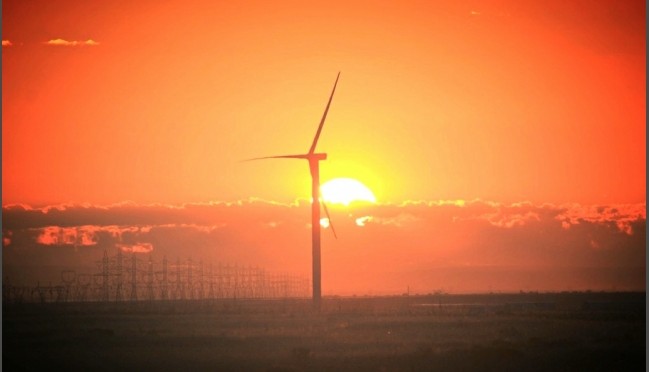The European Union added 11.6 gigawatts (GW) of wind energy capacity in 2012 according to annual statistics released by the European Wind Energy Association (EWEA), bringing the total EU wind energy capacity up to 105.6 GW.
However, the EWEA expects 2013 and 2014 to be challenging years for the wind energy sector.
2012 was another strong year for global wind energy, with cumulative capacity growth reaching 19% lead by China and the US, according to the Global Wind Energy Council’s (GWEC) latest figures.
Outside of the US and China, many nations also saw solid growth. European markets were led by Germany and theUK, with emerging growth from Italy, Poland, Romania and Sweden.
Brazil headed the Latin American market totalling installed capacity of 2,500 megawatts, and Australia accounted for all new Pacific region installations, reaching a total of 2,584 megawatts.
Other wind market leaders to watch include Canada which experienced steady growth, and Mexico, which doubled its installed wind capacity for the year to 1,370 megawatts.
Now 24 countries across the world have a total installed capacity of more than 1,000 megawatts of wind power.
GWEC’s new report shows that while the US had a record year for wind energy, China’s growth was slower due to market consolidation. This meant both nations installed equal wind capacity of just over 13 gigawatts each, claiming joint leadership of the global market.
Steve Sawyer, Secretary General, GWEC said: “While China paused for breath, both the US and European markets had exceptionally strong years. Asia still led global markets, but with North America a close second, and Europe not far behind”.
The report goes on to demonstrate that Indian as well as Chinese installations slowed owing to a lapse in India’s clean energy policy, but the hiatus is thought to be temporary as Asia looks to continue to dominate the global wind markets for 2013.
Amy Davidsen, US Director, The Climate Group, said: “Wind power presents a tremendous opportunity for the US to switch to clean, affordable, reliable power. According to the US Department of Energy, wind could supply as much as 20% of America’s electricity by 2030.
“The recent extension of the production tax credit for wind projects will help ensure that wind capacity continues to grow into 2014. But we need a predictable long-term policy if wind is to reach its full potential in America.”
Changhua Wu, Greater China Director, The Climate Group, said: “A clean energy revolution has been unfolding in China. The last decade has witnessed almost doubling each year of the installation of wind energy in the world’s most populous country. This achievement is made by stronger by clear policy direction and incentives that have beendriving innovation and attracting capital flows.
“And yet we have all seen that challenges remain in order to address the global climate change and energy security. Greater collaboration, cooperation and partnership from both within country and globally will help speed up and scale up the clean revolution; in particular strong partnerships among the major economies, like China and the US.”
“The 2012 figures reflect orders made before the wave of political uncertainty that has swept across Europe since 2011 , which is having a hugely negative impact on the wind energy sector,” commented Christian Kjaer, CEO of EWEA. “We expect this instability to be far more apparent in 2013 and 2014 installation levels.”
The European Union installed 9.4 GW of wind energy capacity in 2011, lower than 2012s 11.6 GW. Wind energy represented 26% of all new European Union capacity installed during 2012, with investments between €12.8 billion and €17.2 billion.
The 105.6 GW wind energy capacity is currently meeting 7% of Europe’s electricity demand, up from 6.3% at the end of 2011.
Last year, wind energy installations were led by Germany (2.4 GW, 21% of all new wind power capacity), the UK (1.9 GW, 16%), Italy (1.3 GW, 11%), Romania (0.9 GW, 8%) and Poland (0.9 GW, 8%). In terms of total installed capacity, Germany is also the leader with 31.3 GW (30%), followed by Spain (22.8 GW, 22%), the UK (8.4 GW, 8%), Italy (8.1 GW, 8%) and France (7.2 GW, 7%).
The UK were happy to have reached third place, overall, up from fifth in 2011. Maf Smith, RenewableUK deputy chief executive, said the figures reflected the growing importance of the British wind industry to the economy, but called for greater certainty over the future of financial support mechanisms for the industry.
“The government is calling for the UK to more than quadruple the amount of wind installed between now and 2020,” he said. “The industry can achieve 31GW onshore and offshore by the end of the decade, but only with clear cross-party political support.”
“We can attract billions of pounds worth of investment to the UK and create tens of thousands of jobs, but only if the signals from Westminster are right. The proof of this will be in the Energy Bill, which is due to become law by the end of the year. So the decisions taken by government over next few months are absolutely crucial for the UK’s wind industry.”
However, the UK is actually underperforming. The UK should have had 8.6 GW of new capacity installed by 2012, instead it only has 8.4. That certainly seems an insignificant difference, but it is representative of a greater problem.
The authors of the report were clear to show that the 2012 figures do not reflect the “significantly negative impact” of economic, regulatory, and political uncertainty that has existed in Europe since 2011.
Most of the capacity installed during 2012 was permitted and approved prior to the negative falloff, and projects going forward are up against the wall.
“The 2012 figures reflect orders made before the wave of political uncertainty that has swept across Europe since 2011, which is having a hugely negative impact on the wind energy sector,” said Christian Kjaer, chief executive of EWEA.
http://www.gwec.net/wp-content/uploads/2013/02/GWEC-PRstats-2012_english.pdf


